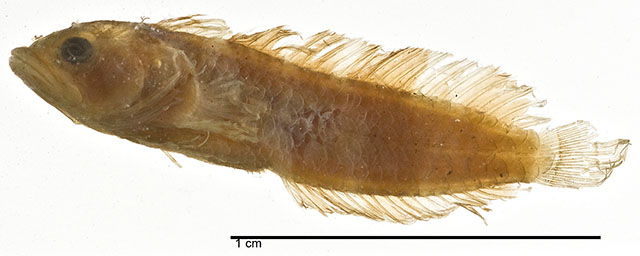| Labrisomidae (Labrisomids) |
| 3 cm TL (male/unsexed) |
|
reef-associated; marine |
| Western Atlantic: southern Florida, USA and the Bahamas to the Greater Antilles and Honduras. |
|
Anal spines: 2-2. Common amongst Labrisomids: small, often elongate fishes; largest species about 20 cm standard length, most under 10 cm standard length. Head usually with cirri or fleshy flaps on anterior nostrils, eyes, and laterally on nape; gill membranes continuous with each other across posteroventral surface of head. Each jaw with an outer row of relatively large, canine-like or incisor-like teeth, often with patches of smaller teeth behind; teeth usually also present on vomer and often on palatines (roof of mouth). Dorsal and anal fins long, frequently highest anteriorly; dorsal-fin spines often flexible, outnumbering segmented dorsal-fin soft rays; 2 usually flexible spines in anal fin; pelvic fins inserted anterior to pectoral-fin bases, with 1 spine not visible externally; all fin rays, including those of caudal, unbranched (simple). Lateral-line tubes or canals varying from complete (extending entire length of body) to present only on anterior portion of body (absent in 1 species). Cycloid (smooth to touch) scales present at least posteriorly on body. Body coloration: varying from drab to brilliant hues; usually with irregular vertical bands, spots, or marbled pattern. Species distinguished by: pectoral-fin soft rays usually 12; no scales on pectoral-fin base; pelvic fin with 1 spine and 2 soft rays; last dorsal-fin element spinous; nuchal cirrus present on both sides of nape; no median fleshy barbel on chin; dorsal-fin elements consisting either of spines only or spines and 1 segmented ray (Ref.52855). |
| Occurs in pockets of coral rubble on reefs or in tide pools. |
|
Least Concern (LC); Date assessed: 18 October 2007 Ref. (130435)
|
| harmless |
Source and more info: www.fishbase.org. For personal, classroom, and other internal use only. Not for publication.
